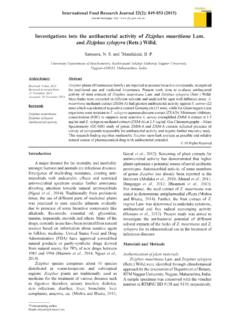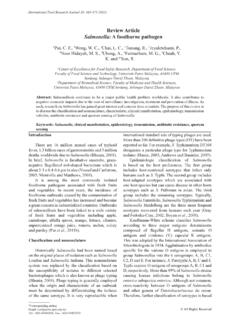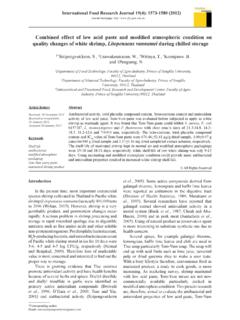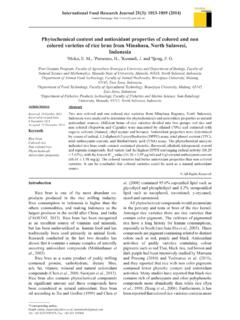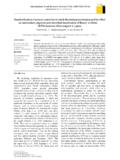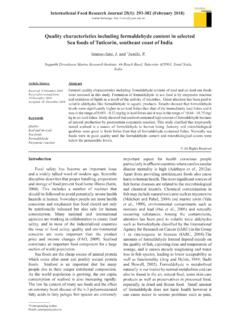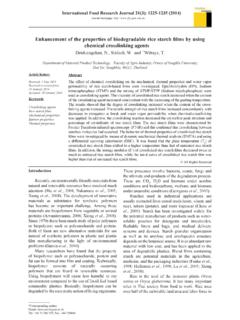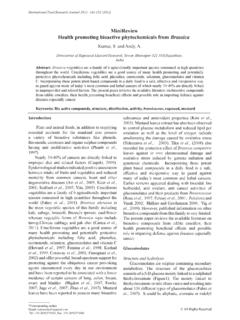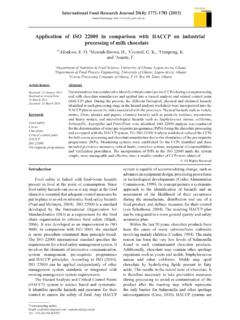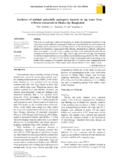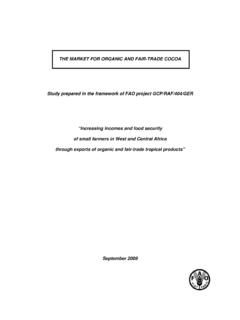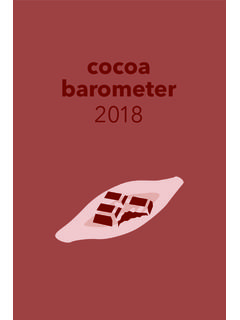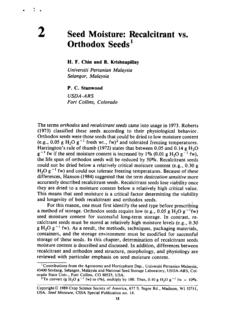Transcription of Optimization of cocoa beans roasting process …
1 All Rights Reserved*Corresponding author. Email: International Food Research Journal 19(4): 1355-1359 (2012)Journal homepage: *Farah, , 1 Zaibunnisa, and 2 Misnawi1 Faculty of Applied Sciences, Universiti Teknologi MARA, 40450 Shah Alam, Selangor, Malaysia2 Indonesia Coffee and cocoa Research Institute, Jl. PB. Sudirman No. 90 Jember 68100, IndonesiaOptimization of cocoa beans roasting process using Response Surface Methodology based on concentration of pyrazine and acrylamideAbstractRoasting is an important process that contribute to formation of flavour compounds in cocoa beans . Pyrazines, a by-product of Maillard reaction is one of the character impact compounds that contribute to unique cocoa flavour. Unfortunately during roasting , carcinogenic acrylamide are also produced through Maillard reaction. Therefore, this study was focussed on optimising the roasting conditions using Central Composite Design (CCD) to produce superior quality cocoa beans with high concentration of pyrazines and low concentration of acrylamide.
2 The roasting conditions used were temperatures in the range of 110oC to 160oC and time ranging from 15 min to 40 min. roasting conditions significantly (p< ) affect the concentration of pyrazines in cocoa beans . However, the RSM analysis shows that the concentration of acrylamide in the beans was not influenced by the roasting conditions. Statistical optimisation based on maximum pyrazines and minimum acrylamide at temperature of 116oC and a time of 23 min produced the desirable value of Hence, the optimized roasting conditions were able to produce high quality cocoa is an important operation for the development of aroma and flavour of cocoa beans at temperatures of 110oC to 140oC and time range of 20 to 50 min (Jinap et al., 1998). Pyrizines has generally been agreed as the main compounds to indicate the quality and quantity of cocoa flavour (Misnawi and Teguh, 2010).
3 Approximately 95 pyrizines have been identified in cocoa aroma and their concentration varied depending on the time and temperature of thermal treatment (Jinap et al., 1998).The precursors of flavour are developed during fermentation and drying of cocoa beans , which include the free amino acid, peptides and reducing sugar, contributing to the development of cocoa specific aroma through Maillard reaction during roasting (Misnawi and Teguh, 2010). During the reaction, aroma precursors interact with each other to produce cocoa flavour such as alcohol, pyrizines, alcohols, ethers, furans, esters, aldehydes and pyroles (Jinap et al., 1998; Puziah et al., 1998). Unfortunately, during roasting , carcinogenic acrylamide are also produced through Maillard reaction. The presence of acrylamide in roasted cocoa beans is due to interactions between asparagines as one of the reactants and dicarbonyl compounds as co-reactant in Strecker Degradation (Maillard reaction) during roasting (Sander et al.)
4 , 2002; Mottram et al., 2002; Becalski et al., 2003; Yasuhara et al., 2003; Zyzak et al., 2003). Acrylamide is categorised as human carcinogen (IARC, 2004) and the exposure to high level of acrylamide may cause damage to the nervous system. Acrylamide has been detected in cocoa product at level up to 909 g/kg (FAO/WHO, 2005). The safe level of acrylamide in cocoa product has yet to be determined. According to the Food and Drug Administration, the safe limit of acrylamide in fries for consumption is ppm. Although the presence of acrylamide in food has not been shown to have effect on human health, it has been shown to be carcinogenic in laboratory animal, thus making acrylamide as a potential carcinogen to human. Several researchers had reported on the effect of cocoa beans roasting conditions on the formation of cocoa flavour compounds (Finken, 1996; KeywordsCocoa bean pyrizinesacrylamideroastingMaillard reactionArticle historyReceived: 9 January 2012 Received in revised form: 14 February 2012 Accepted: 14 February 20121356 Farah et 19(4):1355-1359 Swiechowski, 1996; Nebesny and Rutkowski, 1998; Misnawi et al.
5 , 2003; Ramli et al., 2006). However, optimisation of roasting condition in term of flavour compounds (methyl pyrizine, 2,3 di-methyl pyrizine, 2,3,4 tri-methyl pyrizine and tetra pyrizine) and formation of acrylamide have not been done. The objective of this study is to optimise roasting conditions (time and temperature) for pyrizines and the presence of acrylamide by using rResponse Surface Methodology (RSM).Materials and MethodsCocoa beansIndonesian cocoa beans were obtained from Banyuwangi Plantation, Indonesia - Post Harvest Laboratory of Indonesian Coffee and cocoa Research Institute (ICCRI). cocoa beans were de-shelled and cut to particle size of 10 - 5 mm. The desired cocoa beans were collected using a sieve. The samples were kept sealed in plastic and store at room temperature for further ConditionsRoasting was carried out as suggested by Central Composite Design (CCD) using Design-Expert software version (Stat Ease Software).
6 Two independent variable were used, temperature (110- 160oC) and time (15 - 40 min). Six dependent variable (responses) were determined; 2-methylpyrizine, 2,3-dimethylpyrizine, 2,5-dimethyl pyrizine, 2,3,5-trimethylpyrizine, 2,3,5,6-tetra-pyrizine and acrylamide. The models with statistically significant parameters (P ) were considered and the non-significant parameters (P ) were withdrawn from the model (Jinap et al., 1995). cocoa beans were roasted in a roaster (Mitsubishi Probat Magnetic Contractor model S-N20, the Pascall Engineering Co. Ltd., England).Volatile components To produce cocoa liquor, 5 g of grounded roasted cocoa beans were transferred into capped glass vial. Internal standard of 4-Picoline was applied to the cocoa liquor. SPME fiber Polydimethylsyloxane-Divinylbenzene (PDMS-DVB) polymer was used for extraction.
7 The extraction was held for 30 min at a temperature of 60oC (Misnawi and Ariza, 2011). The flavour compounds in the extract were analysed using GC-FID equipped with Rtx-5(dimethylpolisiloxane crossbone) capillary column, helium with 30 ml/min constant flow as carrier gas and injector SPL-1 operating in splitless mode. The injector temperature was maintained at 260oC and the GC temperature were programmed from 60oC (3 min) to 180oC at 5oC/min for 3 min, following the method described by Puziah et al. (1998). Identification of the component of the standard was carried out by comparing the retention time for the of acrylamideGround roasted cocoa beans were defatted using hydraulic press. The residue was extracted using solid phase extraction (SPE). Five gram of the defatted cocoa powder was added with 10 mL formic acid solution and was shaken for 20 min.
8 The supernatant was filtered through m nylon syringe filter. SPE C18 was conditioned with 2 mL acetone and 2 mL formic acid. Extracted cocoa powder solution was allowed to pass through the tube by gravity flow and the SPE tube was washed with mL water. Excess water was vacuum dried from the tube and 2 mL acetone was used for elution. Sample ( L) was injected and held for min in the GC-FID equipped with Rtx-5 (dimethylpolisiloxane crossbone) capillary column using helium as carrier gas with constant flow of ml/min. The injector temperature was maintained at 260oC and the GC temperature programme was from 100oC ( min) to 200oC at 15oC/min. Result and DiscussionPreliminary studies were conducted at different temperature and time in order to get suitable roasting conditions. The effect of two independent variables (A: temperature of 110 to 160oC and B: time of 15 to 40 min) at five levels were investigated.
9 Response variables were pyrazines (2-methylpyrizine, 2,3-Dimethylpyrizine, 2,5-Dimethylpyrizine, 2,3,5-trimethylpyrizine, 2,3,5,6-tetra-pyrizine) and acrylamide. Pyrizines are heterocyclic nitrogen-containing compound and are extremely important in cocoa flavours. According to Misnawi and Teguh (2010), pyrizines formation and their concentration varied depending on time and temperature of roasting conditions. Prior to roasting , the formation of pyrizines via Maillard reaction, involved amino acids and reducing sugar. Fourteen treatments were assigned based on the CCD for the Response Surface Methodology (RSM) analysis. Central Composite Design (CCD) for pyrizines and acrylamide in the roasted cocoa beans are shown in Table summary of the results obtain from the effect of independent variables; temperature and time on each independent from CCD are shown in Table 2.
10 By using lack-of-fit and coefficient of determination (R2), adequacy of the model can be determined. The significance of equation parameter for all response Farah et 19(4):1355-13591357variables was assessed by F-ratio at probability (p) of Zaibunnisa et al. (2009) suggested that R2 should be at least to have good fit of the model. The closer the value of R2 is to unity, the better the empirical model fits the actual data. Polynomial regression equations relating the responses to the independent variable were generated to obtain the optimal level of two factors (A and B). Numerical optimisation was also carried out to determine the exact optimum level of independent variable leading to desirable roasting condition. Optimizations of the roasting process was based on major flavor compounds (2-methylpyrizine, 2,5-dimethyipyrizine, 2,3,5-trimethylpyirizine and 2,3,5,6-tetra-pyrizine) that have significant model and not significant lack of fit with R2 more than were set as maximun, meanwhile 2,3-dimethylpyrizine was not use in optimisation and acrylamide set as minimum.
